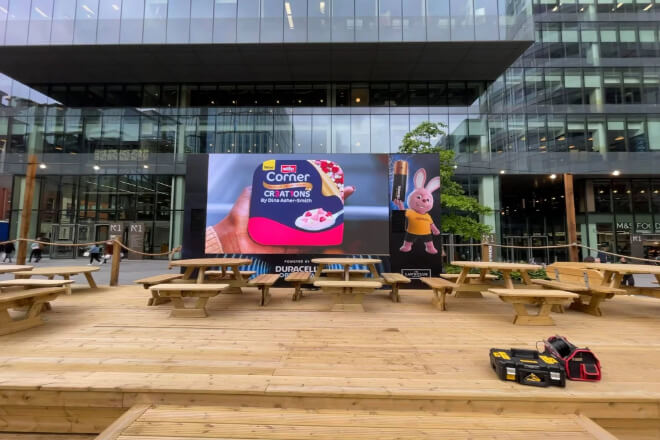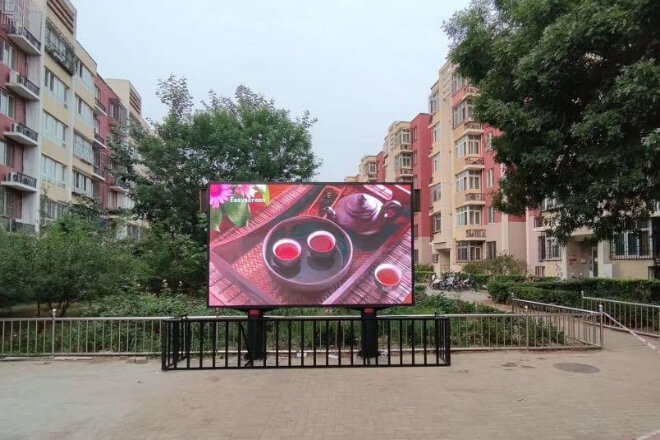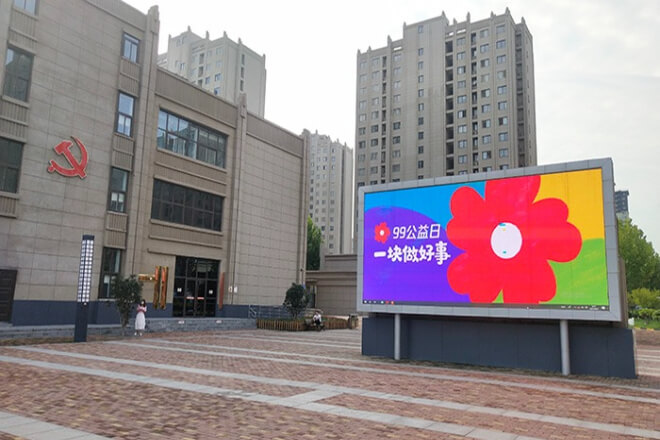مقدمة
التثبيت شاشات ال اي دي at the entrance of residential areas is intended to convey information and add convenience, but if they are not operated properly, they may cause many problems.
Have you ever thought that behind those seemingly ordinary screens, there are actually many taboos that need to be paid attention to?
Today, let us take a deeper look at how to make LED screens truly a “good helper” in the community, rather than a “troublemaker”!
جدول المحتويات
Taboo 1: The brightness of the LED display is too high, which seriously disturbs the residents

When installing LED displays at the entrance of residential areas, سطوع control is really a point that cannot be ignored.
If the screen brightness is too high, especially at night, the glaring light is really unbearable, seriously affecting the rest of the nearby residents, and they can’t sleep well at night.
Over time, everyone will inevitably feel annoyed and may even complain about it, bringing unnecessary conflicts and troubles to the community.
During the day, if the LED screen is too bright, it will make people look at it with sore eyes.
After a long time, visual fatigue cannot be avoided, so the advertising effect is not good, but it becomes a “disturbance artifact”.
Therefore, in order not to disturb the lives of residents, it is crucial to install a system that automatically adjusts the brightness.
This system can automatically adjust the screen brightness according to the changes in the light outside.
When the sun is strong during the day, the screen brightness will automatically increase, and the content can be clearly displayed.
When the light is dim at night, the screen will automatically dim to avoid light pollution.
This not only ensures the information transmission of the LED screen, but also prevents residents from feeling “light bombed”.
What’s even better is that this can also protect the LED screen itself and avoid premature aging due to high brightness operation.
In general, the brightness control of the LED screen at the entrance of the residential area cannot be sloppy.
Using automatic brightness adjustment well can not only achieve the purpose of advertising, but also provide residents with a comfortable environment.
Both parties will not suffer, which is the practice that everyone is satisfied with. After all, good neighborhood relations can make life more harmonious.
Taboo 2: The content is too "commercialized" and arouses residents' disgust

When installing LED display screens at the entrance of residential areas, content selection is also an issue that cannot be ignored. Many people think that LED screens are used for advertising.
However, if the content is too “commercial”, especially the vulgar, noisy, and exaggerated advertisements, it is easy to disgust residents.
After all, residential areas are places where people live and rest, and everyone hopes that the environment is quiet and comfortable.
If the screen is full of loud, flashing, and exaggerated promotional advertisements all day long, it is completely out of place with the surrounding environment.
Residents will inevitably feel annoyed after a long time, which can even affect their mood and quality of life.
In fact, the content of the LED screen can be more “down-to-earth”. If more public welfare propaganda, community notices, or some small information were put close to the lives of residents, the effect would be better.
For example, community event previews, neighborhood watch, environmental protection tips.
And even weather forecasts will not only not disgust people, but also make everyone feel that this screen is quite useful and part of community life.
In this way, the LED screen not only plays the role of information dissemination, but also helps create a warm atmosphere among neighbors.
When residents see this content, they will naturally feel better and more willing to accept the existence of this screen.
In general, the content of the LED screen cannot be put on simply for the purpose of selling things.
The feelings of residents and the overall atmosphere of the residential area must be considered.
More gentle, positive, and useful information, and fewer “noisy” commercial advertisements, can make the LED screen truly play its value, rather than becoming a “noise maker” in everyone’s eyes.
This not only guarantees the advertising needs of advertisers, but also takes care of the living experience of community residents, and both parties can be satisfied.
Taboo 3: Too strong strobe and dynamic special effects

When installing LED screens at the entrance of residential areas, many people like to make some “dynamic sense”, thinking that flashing and moving are more eye-catching.
But in fact, too much strobe or too fast screen switching will not only have no effect, but may cause trouble.
Especially at night or in dim light, the sudden flashing screen can easily make people uncomfortable.
For people walking, it is not only dazzling but also possible to stumble if they are distracted; for drivers, their attention is disturbed, and accidents may occur if they are not careful, which is not a trivial matter.
Moreover, excessive use of dynamic special effects will also make people feel annoyed.
For example, the content changes every three seconds, and the screen jumps in various ways, which will really dazzle people and make them wonder what you want to say.
Facing this kind of screen for a long time, both residents and passersby will feel tired. In addition, residential areas emphasize quietness and comfort. If the LED screen is like a concert, it will really disturb people’s dreams every day.
Therefore, it is recommended that the content design of the LED screen be stable. The picture is clean, the font is clear, the color is soft.
And the information slowly scrolls or fades in and out. It is not only comfortable, but also easier for people to see and remember.
Dynamic elements are not unusable, but they must be restrained. Don’t fly all over the screen at any time.
After all, this is a residential area, not a shopping mall, not a square. The atmosphere must be right so that everyone can truly accept the existence of this screen.
Taboo 4: Improper installation position, blocking the view or entrance

The location of the LED screen is really critical. Especially at the entrance of the residential area.
If the installation position is not appropriate, it will not only fail to achieve the publicity effect, but may also cause trouble to the residents.
The most typical problem is that the screen directly blocks the residents’ view of the building door number, or even blocks it in front of the entrance and exit, affecting everyone’s daily travel.
Imagine that residents are pushing a baby stroller or carrying a lot of bags home, but there is a big screen at the door, so they have to take a detour. Who wouldn’t be annoyed?
In addition, some screens are installed too close to the corner or close to facilities such as electric poles and distribution boxes, which can easily pose safety hazards.
Although the LED screen is not big, if the installation structure is not reliable, it may cause problems with wind and rain.
If no reasonable maintenance space is left during installation, later maintenance will be troublesome, and it will be difficult to handle if a fault occurs.
Therefore, the installation location of the LED screen should not only consider “where there are many people who can see it” but also “where it is most suitable to install it”.
The location should be scientifically selected based on the flow of people in the residential area, the layout of the door, and the safe passage angle.
It is best to simulate the effect of looking at the screen from different angles in advance to confirm that it will not block important signs, entrances, and exits, or affect the smooth flow of roads.
If it can be installed on the wall, try not to occupy ground space. If necessary, you can also design a structure with adjustable angles to make the information display more flexible.
In short, if the LED screen wants to integrate into the community, the first step is not to “interfere with other people’s normal life”.
If it is installed reasonably, looks comfortable, and is easy to use, everyone will naturally be more accepting of its existence.
If the location is chosen correctly, the content updates and interactive gameplay will be launched later.
5. Conclusions
Through the above analysis of the taboos of LED screens at the entrance of residential areas, I believe you have a clearer understanding of how to use LED screens reasonably.
Remember, technology is to make life better, not to create troubles. I hope these tips can help you create a harmonious and comfortable community environment!
وأخيرًا، إذا كنت تريد معرفة المزيد عن شاشات العرض LED، يرجى الحصول على اتصال معنا.
